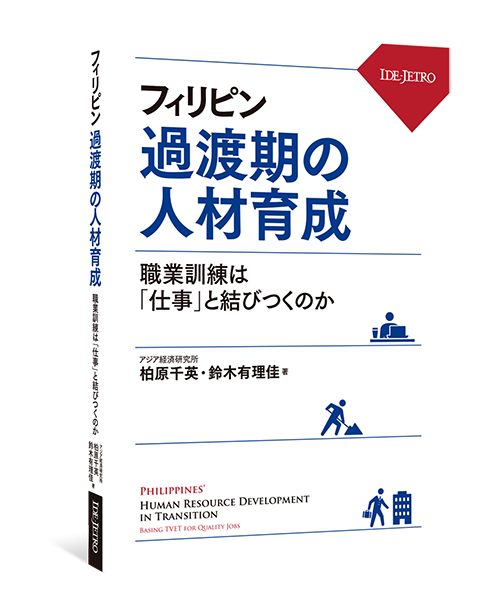Japanese eBooks
eBook

The Changing State of Human Resource Development in the Philippines: The Connection between Vocational Training and Quality Jobs
Download eBook for free
Available in EPUB and PDF format for full book. EPUB files can be opened in eBook readers.
About this book
About this book
In the Philippines, the Technical and Vocational Education and Training (TVET) system was restructured in the late 1990s to strengthen human resource development and provide lifelong educational opportunities. The inclusion of TVET programs in the public scholarship system and reform of the basic education system (commonly known as “K to 12”), which took effect in the mid-2010s, have led to TVET becoming a part of the educational curriculum. The current TVET system, which was expanded to cover a total of approximately 2.5 million graduates in 2019 just before the COVID-19 crisis, is now taking shape. But this change also reflects the policy orientation of past administrations, which were forced to pursue the twin goals of “reducing the difficulties faced by young people in their initial job search” and “the continuous upgrading of domestic human resources.”
This calls into question whether TVET’s objectives have been realized. If not, what are the factors and challenges involved, and do they vary by region or industry? To address these questions, we first provide an overview of reforms to the educational and TVET systems, as well as the domestic employment situation, recent TVET achievements, and the job-searching and working environments of TVET graduates. Then, as industry-specific examples, we analyze the agriculture and fisheries, which have absorbed less-educated and unskilled labor, as well as the information and communications technology-business process management (ICT-BPM) industry, which requires highly skilled human resources. We also include a supplemental chapter explaining the development of legal reforms related to secondary and higher education and TVET since 2000.
Contents
Preface
Introduction Technical and Vocational Education and Training (TVET) and Employment in the Philippines
Author:Chie Kashiwabara, Yurika Suzuki
Chapter 1 Progress in Curriculum and TVET System Reforms
Author:Chie Kashiwabara
Chapter 2 Job Searching and the Working Environments for TVET Graduates
Author:Chie Kashiwabara
Chapter 3 TVET and the Agriculture and Fisheries
Author:Yurika Suzuki
Chapter 4 TVET and The Information and Communications Technology-Business Process Management (ICT-BPM) Industry
Author:Chie Kashiwabara
Supplemental Chapter: Development of Laws Related to Higher Education and TVET System Reform
Author:Chie Kashiwabara
Preface
Preface
People need to acquire knowledge and master skills at various times and for various reasons, but they cannot always do so in the setting of primary, secondary, or higher education. In addition, they may be constrained in terms of how much time, period or money they can devote to furthering their education and training. Although such problems may exist regardless of a country’s economic and developmental circumstances, the situation tends to be more serious in developing countries, where various social security and support systems remain inadequate. If a person is unable to obtain compensation for their labor, or if their income level remains quite low for a long period of time, not only their own livelihood but also their household investment in their children’s education will be constrained, thereby forming the so-called “chain of poverty.”
One of the systems that has emerged to provide the means and opportunities to meet the needs mentioned above is “technical and vocational education and training” (TVET). In a narrow sense, TVET provides educational and training courses positioned between the secondary and higher education systems. In a broader sense, it provides opportunities as part of life-long education and employment support, without necessarily requiring enrollees to be a specific age or have a certain level of educational attainment.
In the Philippines, the TVET system was restructured in the late-1990s based on the broader definition and was later expanded along with the education system reforms introduced in the early 2010s. Before the COVID-19 pandemic, the country, which has a population of over 110 million with a median age at its mid-20s, sends around 1 to 2 million overseas Filipino workers (OFWs), including professionals and both skilled and unskilled workers. However, to raise income levels, join the ranks of upper middle-income countries, and achieve the long-term national goal of a “society without poverty,” it is considered essential to solve the following problems: 1) unemployment and underemployment among low-educated and unskilled youth, 2) stagnation in upgrading the skills and knowledge of workers and the sophistication of domestic industries, and 3) difficulties in the labor market for career advancement and change at the individual level. This book is the result of an attempt to analyze the efforts and achievements so far, with the aim of deriving challenges and policy implications in view of TVET, education, and the job-searching/employment environment in the Philippines, under the research project “Vocational Education, Employment, and Economic Development in the Philippines” conducted in FY2019−2021.
Because of the COVID-19 pandemic, we could carry out part of our research activities, such as interviews and queries only via online. The government officials as well as the academics and researchers in the Philippines kindly made time and shared their data and insights with us, despite tighter restrictions on travel than even in Japan. We would like to express our sincere appreciation to them and look forward to repaying their kindness the next time we meet them in person in the Philippines.
We must pay close attention to the changes triggered by the pandemic in the education/TVET setting as well as the labor market in the Philippines. Will workers, regardless of industry, receive higher compensation and gain access to better working conditions? Will they be given the chance to improve their knowledge and skills and thereby increase their productivity? Will they be able to seek and obtain useful career counseling and change their career track when they so desire?
Only when these questions can be answered in the affirmative, will a “society without poverty” be achieved.
January 2023
Chie Kashiwabara


